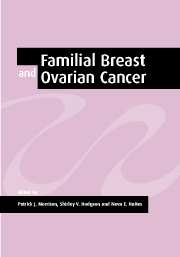Book contents
- Frontmatter
- Contents
- List of contributors
- Foreword by Helena Kennedy
- Preface
- Acknowledgements
- Part 1 Molecular biology and natural history
- 1 Introduction
- 2 Overview of the clinical genetics of breast cancer
- 3 Cowden syndrome and related disorders
- 4 Overview of the clinical genetics of ovarian cancer
- 5 Ovarian and breast cancer as part of hereditary non-polyposis colorectal cancer (HNPCC) and other hereditary colorectal cancer syndromes
- 6 The natural history of hereditary breast cancer
- 7 Pathology of the breast and ovary in mutation carriers
- 8 Risk estimation for familial breast and ovarian cancer
- Part 2 Screening
- Part 3 Management
- Index
2 - Overview of the clinical genetics of breast cancer
Published online by Cambridge University Press: 24 August 2009
- Frontmatter
- Contents
- List of contributors
- Foreword by Helena Kennedy
- Preface
- Acknowledgements
- Part 1 Molecular biology and natural history
- 1 Introduction
- 2 Overview of the clinical genetics of breast cancer
- 3 Cowden syndrome and related disorders
- 4 Overview of the clinical genetics of ovarian cancer
- 5 Ovarian and breast cancer as part of hereditary non-polyposis colorectal cancer (HNPCC) and other hereditary colorectal cancer syndromes
- 6 The natural history of hereditary breast cancer
- 7 Pathology of the breast and ovary in mutation carriers
- 8 Risk estimation for familial breast and ovarian cancer
- Part 2 Screening
- Part 3 Management
- Index
Summary
Introduction
Breast cancer is the most common cancer in women, accounting for 20% of all new cases of cancer. The lifetime risk to a woman in the UK is 1 in 12 females, with an incidence of less than 10 per 100 000 women aged under 30 years, rising to 300 per 100 000 in women aged over 85 years. Breast cancer can occur in sporadic and hereditary forms, and both forms are associated with modification to the genetic material. In the case of hereditary forms, a constitutive mutation in a specific gene predisposes individuals to cancer. In sporadic forms, mutations in somatic cells accumulate and result in transformation of a normal cell to one with malignant potential.
Statistical analysis of epidemiological data is compatible with a dominant gene (or genes) predisposing to breast cancer in certain families, with 5–10% of breast cancer being due to highly penetrant, dominant genes (Easton and Peto, 1990; Claus et al., 1991). Approximately 10% of isolated cases presenting under 35 years may be due to such a gene but only 1% of cases presenting over 80 years (Langston et al., 1996; Ford et al., 1998).
Table 2.1 lists genetic syndromes that may predispose to breast cancer, some of which will be discussed in this chapter and in some greater detail in subsequent chapters.
Family history as an indicator of predisposition to breast cancer
A history of breast cancer among relatives has been found, in epidemiological studies, to be an indication of breast cancer risk.
- Type
- Chapter
- Information
- Familial Breast and Ovarian CancerGenetics, Screening and Management, pp. 6 - 21Publisher: Cambridge University PressPrint publication year: 2002
- 1
- Cited by



